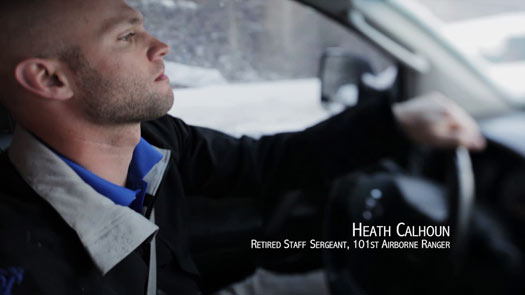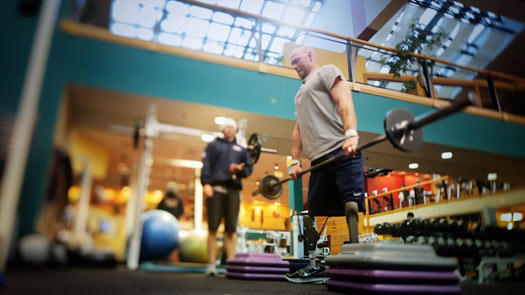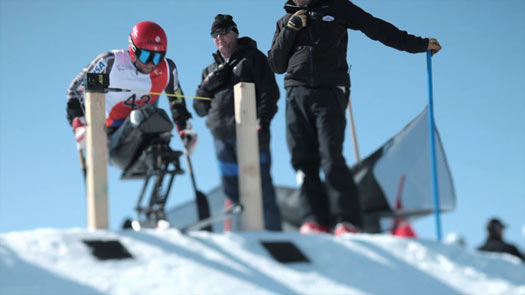How Canon DSLRs and Adobe CS5 Put Him in Documentary Mode
To see a 90-second trailer: www.tylerstableford.com/thefallline.
Stableford shot that documentary with essentially a still-shooting rig, augmenting his camera with a tripod and a small field audio recorder. “But I wanted to learn higher-end techniques,” he explains. That desire led him to “The Fall Line,” In truth, he had it easy. For his stills work, he had already been selected as one of Canon’s Explorers of Light, a group of talented photographers who tout their experience working with Canon gear. And, as a power user of Photoshop and Lightroom, he’s long been tight with Adobe, which was happy to help him and his “Fall Line” editor, Dave Wruck, get up to speed with a beta version of CS5 earlier this year. Stableford refers to it as a “leap of faith” on Adobe’s part, but the beta provided him and Wruck a bug-free environment for editing.

Getting the Story
But Stableford didn’t have Wruck on board when he started shooting. He wanted to move quickly to tell the story of a U.S. Army Iraq War veteran and double-leg amputee who learned to compete in ski contests using a monoski, also known as a sit-ski. “I got the lead on this story from Heath Calhoun’s coach, who’s a friend here in my town,” he explains, noting that he first met Calhoun four years ago, when he was just learning to ski. “His coach told me, ‘Heath is winning some amazing World Cup ski races, he’s the national Super G champion, and he has a strong chance of qualifying for the Paralympics this year.’ I jumped on the opportunity and hired a number of consultants to get me up to speed in shooting.”
The results were impressive. Wruck says the story was remarkably complete in the footage Stableford delivered to his desktop. That’s good, because by the time the edit started, Heath had already left Colorado and wasn’t available for pick-up shots. “Tyler had so much coverage it was ridiculous,” Wruck says. “It was almost too much, but he managed each shoot extremely well. It was helpful to have three or four camera angles on every single thing.”
Learning by Doing
Stableford says he concentrated on learning the basics of the craft. “I considered this film kind of like going to grad school – it would probably cost about the same, and I wanted to learn as best I could,” he says. Fortunately, he was able to hire an experienced cinematographer – Kent Harvey, a well-known second-unit DP with Hollywood credits including Spider-Man 3, both Iron Man movies, and the currently filming Cowboys & Aliens. “He came on set for two or three days and helped us learn how to build a story,” Stableford says.
After Harvey left, the shoot finished up with Stableford and his first assistant, Draper White, running the cameras. They used Canon 5D and 1D Mark IV camera bodies augmented by equipment from companies like Redrock Micro, Manfrotto, and Marshall Electronics that allowed cinema-style shooting with the DSLRs. Meanwhile, Stableford’s studio manager, Stephanie Kilts, got quickly up to speed with capturing field audio. She used Zoom Audio’s H4n field audio recorders on the shoot. [For a more complete list of gear, see Stableford’s blog entry on the shoot.]

“I love using ultra-wide lenses in my stills photography, and I wanted to bring that to motion as well,” Stableford says. “I used the fastest prime lenses that Canon has – the [L-series] 24mm f/1.4, 50mm f/1.2, and the 85mm f/1.2. Some tilt-shift lenses, too. I wanted to learn how to use those in motion. I might look back and say that some of it was overdone, but I wanted to learn and push myself and make mistakes while no one else was paying me to make mistakes on their time.” [For more details on the cinematography, see Kent Harvey’s behind-the-scenes blog entry.]
Footage that Stableford’s team didn’t capture includes a few seconds of archival footage near the end of the film that was originally shot with a Sony XDCAM EX3, as well as some night-vision footage, also shot with the 5D, that was provided by the U.S. Army’s 55th Combat Camera company. “They’re fighting cameramen, carrying guns and cameras, too,” Stableford says. “There’s a lieutenant named Tyler Ginter who’s into the DSLR workflow, and he gave me stuff from Iran and Afghanistan. We all got excited about the footage – which was free from the government – and it grew the story far out of Aspen, which was nice.”
The combination of footage was a bit unwieldy, since Canon hadn’t yet updated the 5D’s firmware to support all of the formats a videographer might rely on. While footage from the 1D Mark IV was shot at 29.97 fps, the 5D was shooting 30 fps. The shot from the EX3 was taken at 59.94 fps. After some experimentation, Stableford and Wruck decided to lock the project at 30 fps to match the majority of the footage. “Because it’s a short film and there weren’t any shots of excessive length, we never had any kind of sync issues,” Wruck says.
I’m a Mac and He’s a PC
Another potential wrinkle: Stableford was a Mac and Wruck was a PC. “We had issues with large files, which had nothing to do with Adobe but with the FAT32 file format,” Stableford says. “But once we had all the assets duped, he and I could pass project files back and forth really easily.”
“When [colorist] Eric [Espera] got on board, he was in San Francisco on a Mac, Tyler was in Aspen on a Mac, and I was in Denver on a PC. We were passing the project file around all the time, emailing it back and forth, but we all had the same assets, so it opened up really nicely,” Wruck says. “The only problem was an instance with one specific JPEG image, where the rotation would change between PC and Mac. It would either be 90 degrees clockwise or counterclockwise. We noted that, and every time we opened each other’s projects, we’d go to that picture and adjust the rotation. That was it.”
That glitch remains a bit of a mystery. “None of the other still images were affected, including images taken with the same camera,” Stableford says.
White, Stableford’s first assistant, worked in Photoshop to get various still images ready to import into the project, then transferred those skills to After Effects, where he removed dust from the camera lens and handled boom removal in some shots. “The cool thing about Adobe is that you can apply skills from one piece of software in another, and his Photoshop skills were so handy in After Effects,” Wruck says. In fact, Wruck and Stableford accepted an unspoken challenge to keep the production in CS5 – for example, Espera, a video production specialist at Adobe, graded the film entirely within Premiere.
“We’ve been outputting every format,” Wruck says. “We’ve done Blu-rays. We’ve done DVDs. We haven’t made any HDCAM tapes, but the time may be nigh if a festival accepts it. The Adobe Media Encoder has really stepped up its usefulness in CS5. And we have learned some very cool tricks involving the H.264 codecs. Adobe’s insight into the engineering has been really helpful.”
Sadly, neither Stableford nor Wruck had the appropriate hardware from NVIDIA to take advantage of Adobe’s new Mercury Engine acceleration for the graphics card-maker’s Cuda architecture. “Watching that wheel spin [on the Mac screen], whether it’s in Photoshop, Lightroom, or Premiere, just shuts the door on your creativity,” Stableford says. “You might want to know, ‘How will this filter look?’ But if that wheel is spinning too long, it’s a huge deal. [The Mercury Engine] is going to open up creativity for all of us.”

Finding the Audience
Where, exactly, “The Fall Line” will be shown is an open question. It premiered at the 5 Point Film Festival in Carbondale, CO, in May, and will be donated to the U.S. Paralympic Team as a fundraising vehicle. It may show up at Canon’s online Digital Learning Center to promote DSLR filmmaking, and could also be hosted at Adobe’s website. But Stableford is busy submitting it to film festivals, as well. “I’m even newer to learning those markets than I am to shooting motion,” Stableford says with a sigh.
And there’s a dilemma that faces every filmmaker – no matter how good you are at building a narrative, making a living is equally important. “I’m still trying to figure out how and where, exactly, the money comes from in filmmaking,” he says. “Maybe veterans who have been doing it for 20 years are trying to figure out the same thing. I can sell a still photo here and there, but I’m not an expert on feeding my family with a video camera yet.”
Sections: Creativity Technology
Topics: Feature Project/Case study
Did you enjoy this article? Sign up to receive the StudioDaily Fix eletter containing the latest stories, including news, videos, interviews, reviews and more.
Leave a Reply